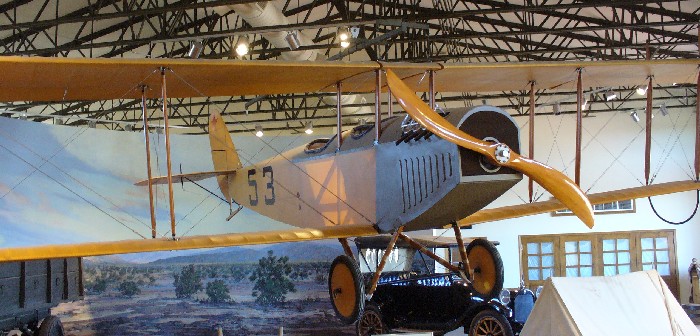Remember your U.S. History?
Q. Where was the last invasion of the continental United States and when?
A. Columbus, New Mexico on March 9th 1916 by Pancho Villa, leader of a rebel army from Old Mexico.
We are there and we are taking part in the festivities. We took part of a guided tour by a local resident and the grandson of one of the villagers who died that morning in 1916. We also rode “Path” our trusty tandem bicycle to the Mexican border three miles away, a preview of tomorrow’s Cabalgata Horse Parade from across the border. There will be re-enactors representing the doughboys of world war I which followed closely on the heels of this skirmish. After the burning of Columbus, President Woodrow Wilson sent General Pershing and 10,000 troops into Mexico after Pancho Villa. They brought the first aircraft into this battle along with trucks and cars. A radical new concept in warfare at the time. They started out with the JN3 Jenny biplane which was a wee bit short of power to make it through the Mexican mountains south of here.
The exhibit included a full scale reconstruction of an JN3 Jenny along with the instructions for flying this airplane.
How to Fly a Jenny!
1. Inspection: It is best not to inspect this ship. If you do you will never get into it.
2. Climbing into the cockpit: Do not attempt to enter the cockpit in the usual way. If you put your weight on the lower wing panel, it will fall off, and besides, your foot will go through the wing, probably breaking your leg. The best way to enter the cockpit is to climb over the tail surfaces and crawl up the turtle back. Be sure to brush the gopher and squirrel nests out of the cockpit. Take care not to cut your hands on the remnants of the windshield.
3. Instruments: after having carefully lowered yourself into the cockpit and groped in vain for the safety belt, take a good look at the instruments, both of them. The one on the right is the tachometer. It doesn’t work. The other one is the altimeter, and it functioned perfectly until 1918, when the hands came off. Look at them, for when the engine starts you won’t be able to see them because of vibration.
4. Starting the motor: The switch is on the right. It doesn’t work because it’s not connected. However, it gives a sense of confidence to your mechanic who is pulling the prop through if he can hear the switch click when you say, “Switch off.” If for some reason the motor doesn’t start, don’t get out and pick up the cut and bleeding mechanic, he deserved it.
5. Warming up: Don’t warm up the engine. It will only run a few minutes anyway, and the longer it runs on the ground the less flying time you have. After the throttle is opened, do not expose any portion of your body outside of the cockpit. It is no fun having your face slapped by a flying rocker arm, or being peppered by small bits of piston rings, valves etc. that are continually coming out of the exhaust stacks.
6. The takeoff: The takeoff is in direct defiance of all the laws of nature. If you have a passenger, don’t try it.
7. The flight: After you have dodged trees, windmills and chimneys you will fly out over the lake. Note that there is a large hole in the left side of the fuselage. This hole is to allow the stick to be moved far enough to make a left turn. Don’t try one to the right.
8. The landing: The landing is made in accordance with the laws of gravity. If the landing gear doesn’t collapse on the first bounce, don’t worry it will on the second. After you’ve extricated yourself from the wreckage and helped the spectators put out the fire, light a cigarette, and with a nonchalant shrug, walk disdainfully away.
From Pancho Villa State Park exhibit. Author unknown.
